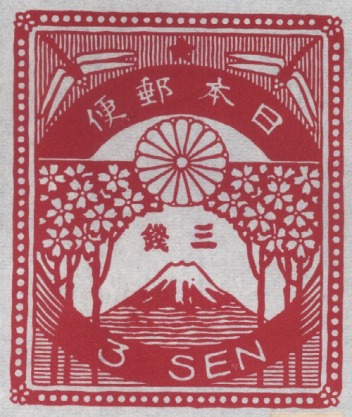Fuji Dragonflies
|
In 1923 there was a terrible earthquake in Tokyo, and tens of thousands perished in a fiery holocaust. The postal facilities where stamps were printed and stored were destroyed, and much of the governmental infrastructure as well. With the government nearly shut down, emergency printing of postage stamps was contracted out to private printers, none of whom were equipped with machines to create the perforations or add the adhesive gum. The stamps thus had a somewhat antique appearance, but citizens nervous that the government had been dealt a fatal blow were reassured. "The Earthquake Issue" has since become highly collectible.
The 3s bright rose [Scott #182], designed by Morimoto Shigeo, brings together several legendary symbols of Japan in a modern-looking way. A Chrysanthemum is the central element, a representation of the Imperial family of Japan. It appears on every Japanese stamp from 1872 until the end of World War II. In the lower section cherry trees with stylized cherry blossoms frame Mt. Fuji, and above are two dragonflies flanking a central star. The star symbolizes the fact that the island was under martial law after the earthquake, a measure needed to protect the common safety. The dragonfly is a symbol of Japan and victory. Ancient legends hold that when the first emperor, Jimmu, descended from heaven, the shape of the island archipelago from his divine height reminded him of a dragonfly, "akitsu." He christened his regime "Akitsu-shima" or "The Land of The Dragonfly." |
|
Provenance:
Paper Type: Rice Paper, Legion Mulberry White 38 [Utrecht #19118] Paper Size: 9.75" x 13" [24.8cm x 33cm] Image size: 4" x 5" [10.2cm x 12.7cm] Edition Size: 50 Inks Used: Van Son Rubber-based Reflex Blue Date cut: 8 Jun 1999 Production Notes: I scanned a Japanese postage stamp [Scott #182] then printed a reversed copy onto parchment paper [Bienfang No. 100] and glued this onto the linoleum block using Photo Mount [3M No. 6092]. I cut directly through the paper using stencil cutters under a stereo dissecting microscope [Bausch & Lomb 13x’] and printed as a collage with a genuine stamp glued [UHUstic Baton de colle] in the lower right corner. |
Available:
$25.00 USD $500 MXN Shipping: $15.00 with tracking to USA |

